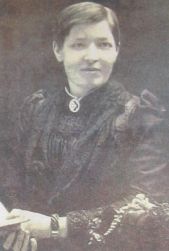Mary Slessor: White Mother of West Africa
Among those inspired by the life and death of David Livingstone was Mary Slessor (1848 – 1915), who ventured alone into Calabar, a remote area of present-day Nigeria. She was one of the thousands of women who flooded into foreign missions in the late nineteenth and early twentieth centuries. Scottish Presbyterians sponsored her even as they had sponsored her hero David Livingstone. Indeed, by the time she ventured into Africa in the mid – 1870s, denominational mission boards were beginning to open the doors to women.
Like Livingstone, Mary Slessor had grown up in poverty and had worked long hours in textile mills as a child. Unlike the Presbyterian missionary wives serving in Calabar, she lacked sophistication, and in her leisure time she preferred climbing trees to attending afternoon tea parties. Her initial assignment was to teach in a school at Duketown, but dissatisfied with the social niceties and ample lifestyle of the other missionaries, she convinced the mission director to assign her to a post in the interior, where she adopted the African way of life. She ate native food and lived in a mud hut with her adopted African children — often children who were deemed demonic and rejected by their families.
In the following years she served as a teacher and medical specialist among the local people. On Sundays she traveled on a circuit deep into the jungle, preaching to any who would listen. But always restless, she was convinced that her calling was to preach in an even more remote area. In 1888, with the help of a local chief, she moved “up country” to the Okoyong district. “In the forenoon I was left alone with the mud and the rain and the general wretchedness,” she wrote. “I looked helplessly on day after day at the rain pouring down on the boxes, bedding, and everything.” There was no privacy. Packed tight in the tiny hut with a mud floor were two girls and three boys as well as the locals who “crowded in on every side” — not just men, women, and children, but also “goats, dogs, fowls, rats and cats all going and coming indiscriminately.”
For more than a quarter century she would continue her multifaceted ministry in a region where no missionary had ever gone before. In 1892 she became the first British vice-consul to Okoyong, serving as a highly respected judge among the people. Twelve years later she moved on to an even more remote tribe, always considering her work as paving the way for other missionaries rather than church planting. She turned down a marriage proposal and was unable to work effectively with single women who joined her. Africa was her home, and Africans were her people. Today she continues to be remembered in Nigeria as the great Mother Slessor. Of her legacy, journalist Mary Kingsley wrote:
This very wonderful lady has been eighteen years in Calabar; for the last six or seven living entirely alone, as far as white folks go, in a clearing in the forest near one of the principal villages of the Okoyong district, and ruling as a veritable white chief over the entire district. Her great abilities, both physical and intellectual, have given her among the savage tribe a unique position, and won her, from white and black who know her, a profound esteem. Her knowledge of the native, his language, his ways of thought, his diseases, his difficulties, and all that is his, is extraordinary, and the amount of good she has done, no man can fully estimate. Okoyong, when she went there alone . . . was given, as most of the surrounding districts still are, to killing at funerals, ordeal by poison, and perpetual internecine wars. Many of these evil customs she has stamped out. . . . Miss Slessor stands alone.
If you enjoyed the above article, please take a minute to read about the book that it was adapted from:
Parade of Faith: A Biographical History of the Christian Church
by Ruth A. Tucker
The story of Christianity centers on people whose lives have been transformed by the resurrected Lord. Tucker puts this front and center in a lively overview peppered with sidebars; historical “what if?” questions; sections on everyday life; drawings and illustrations; bibliographies for further reading.




